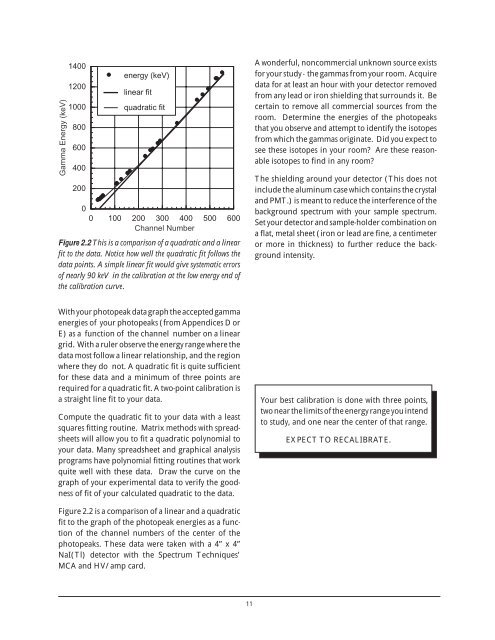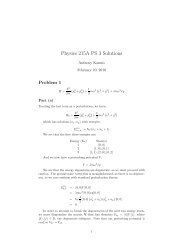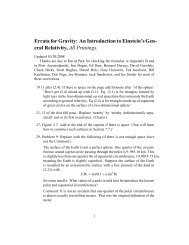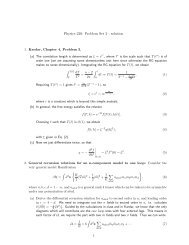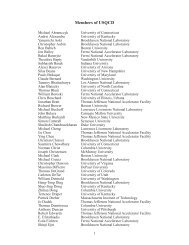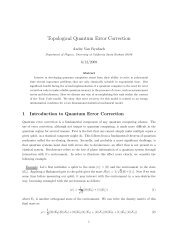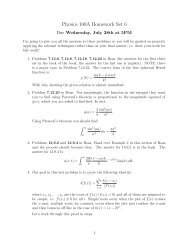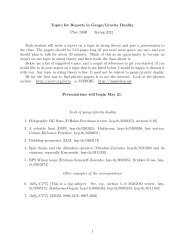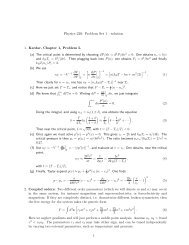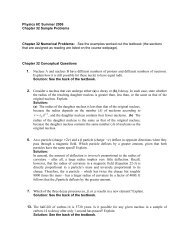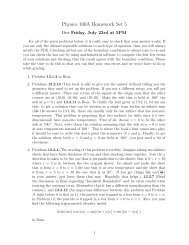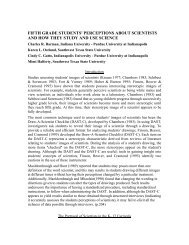Nuclear Spectroscopy
Nuclear Spectroscopy
Nuclear Spectroscopy
Create successful ePaper yourself
Turn your PDF publications into a flip-book with our unique Google optimized e-Paper software.
Gamma Energy (keV)<br />
1400<br />
1200<br />
1000<br />
800<br />
600<br />
400<br />
200<br />
X energy (keV)<br />
X XXXX<br />
linear fit<br />
quadratic fit<br />
X<br />
X X X XXX<br />
0<br />
0 100 200 300 400 500 600<br />
Channel Number<br />
Figure 2.2 This is a comparison of a quadratic and a linear<br />
fit to the data. Notice how well the quadratic fit follows the<br />
data points. A simple linear fit would give systematic errors<br />
of nearly 90 keV in the calibration at the low energy end of<br />
the calibration curve.<br />
A wonderful, noncommercial unknown source exists<br />
for your study - the gammas from your room. Acquire<br />
data for at least an hour with your detector removed<br />
from any lead or iron shielding that surrounds it. Be<br />
certain to remove all commercial sources from the<br />
room. Determine the energies of the photopeaks<br />
that you observe and attempt to identify the isotopes<br />
from which the gammas originate. Did you expect to<br />
see these isotopes in your room? Are these reasonable<br />
isotopes to find in any room?<br />
The shielding around your detector (This does not<br />
include the aluminum case which contains the crystal<br />
and PMT.) is meant to reduce the interference of the<br />
background spectrum with your sample spectrum.<br />
Set your detector and sample-holder combination on<br />
a flat, metal sheet (iron or lead are fine, a centimeter<br />
or more in thickness) to further reduce the background<br />
intensity.<br />
With your photopeak data graph the accepted gamma<br />
energies of your photopeaks (from Appendices D or<br />
E) as a function of the channel number on a linear<br />
grid. With a ruler observe the energy range where the<br />
data most follow a linear relationship, and the region<br />
where they do not. A quadratic fit is quite sufficient<br />
for these data and a minimum of three points are<br />
required for a quadratic fit. A two-point calibration is<br />
a straight line fit to your data.<br />
Compute the quadratic fit to your data with a least<br />
squares fitting routine. Matrix methods with spreadsheets<br />
will allow you to fit a quadratic polynomial to<br />
your data. Many spreadsheet and graphical analysis<br />
programs have polynomial fitting routines that work<br />
quite well with these data. Draw the curve on the<br />
graph of your experimental data to verify the goodness<br />
of fit of your calculated quadratic to the data.<br />
Your best calibration is done with three points,<br />
two near the limits of the energy range you intend<br />
to study, and one near the center of that range.<br />
EXPECT TO RECALIBRATE.<br />
Figure 2.2 is a comparison of a linear and a quadratic<br />
fit to the graph of the photopeak energies as a function<br />
of the channel numbers of the center of the<br />
photopeaks. These data were taken with a 4” x 4”<br />
NaI(Tl) detector with the Spectrum Techniques’<br />
MCA and HV/amp card.<br />
11


